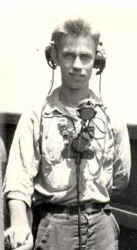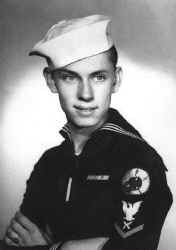Wayne Fowers
Yoeman Third Class
 |
Wayne is one of the principle
historians of the AARON WARD.
He has contributed greatly in time,
information,
and photos for this web site. |
 |
"World War II was still raging when I graduated
from Hoover High School in San Diego. It was the end of January 1944. Having
grown up in San Diego, I was quite used to the presence of navy so upon
graduation it was the focus of my attention, knowing that military service would
not be optional.While still in high school, I investigated the V5 program
(naval aviation) and had been accepted but decided against it at the last
minute. Instead, I enlisted and was given six weeks before reporting to boot
camp on my 18th birthday . In boot camp, I was assigned to the class A service
school for yeomen. As soon as they found out I could type, I was immediately
designated "yeoman" and my fate in the navy was cast in stone. |
After
sixteen weeks of yeoman school, I was handed orders to report to Treasure Island
in San Francisco, assigned to the pre-commissioning detail of the U.S.S. AARON
WARD (DM34), under construction at Terminal Island in San Pedro, California.
That is where I first met LtCdr Karl F. Neupert who was in charge of the detail
as newly-assigned sailors arrived for destroyer training. I was his yeoman, even
though only a seaman first class with qualified striker status. I served LtCdr
Neupert from then until he was ordered to his own command from the AARON WARD,
following her near-destruction on 3 May 1945. I will always remember Mr. Neupert
as one of the finest men I have ever known and certainly the smartest. Tears
filled my eyes as they did his; he said “goodbye” and left the AARON WARD.
While aboard, I also became quite close to our Skipper. He
was a San Diego native and his wife, children and parents still lived there as
did my parents.
I was assigned as talker on the bridge for the Captain
during special sea detail as well as during general quarters. My regular
underway watches were also on the bridge as talker for the officer-of-the-deck.
So whenever anything important was going on I was in the thick of it and pretty
much in the know, as I was always on the bridge during such times. When Captain
Sanders learned that I also grew up in San Diego and that my parents lived
there, he came to know me quite well. He was a unique human being as a naval
officer. He took a personal interest in his people, no matter what their rate,
rank or status. As a result of his caring, his parents made contact with mine
and became valued friends
.
Aboard ship, whenever the Captain or the Executive Officer
(Neupert) needed a yeoman to take inspection notes or to keep the log for
Captain's Mast, it seemed I was always the lucky one. As a result I became
well-acquainted with two very fine but very different naval officers. I shall
never forget either of them. Captain Sanders really cared about his men and I
believe that it was important to him that they liked him. Sometimes, when
underway, we might find it difficult to locate the Skipper, only to find him
sitting on the mine tracks on the fantail, shooting the breeze with the mess
cooks. He was so human and so unpretentious.
The Exec was different. He seemed to feel the weight of his
responsibilities and so came across as tough and unsympathetic. I remember one
specific incident where the wife of one of our shipmates was expecting. The Exec
turned down his request for leave since we were in the process of shakedown
which included all kinds of training which would become critical in the event we
were to see action. Many thought this was too tough and uncaring; little did
they know, the Exec's wife was due to give birth as well. He didn't consider
leave because of his duty to the ship and it's crew.
After the attack of 3 May while tied up to the U.S.S.
ZANIAH in Kerama Retto awaiting our fate, I accompanied the Skipper and the
senior MinePac officer who came aboard to assess the damage and to determine
what should be done. At the conclusion of the inspection, our Skipper was told
that the damage was so severe that we would never be able to keep up with a
convoy back to the States. All useable gear should be salvaged, the Ship
scrapped and the men transferred to other minecraft to replace casualties.
The Skipper rose to the support of his men, "you give
me a week, sir, and we'll keep up with any goddam convoy you can put
together". The rest is history. With the help of the men from the ZANIAH,
repairs were made, non-critical gear was salvaged (including a propeller and
shaft, sound gear, etc.) and we completed satisfactory sea trials. A few days
later we joined a convoy and ultimately arrived in San Diego. All west coast
navy yards were full and we were ordered to the Brooklyn Navy Yard via the
Panama canal. After work was commenced on AARON WARD's repairs, the war in
Europe ended. The repairs were suspended and we were ordered decommissioned and
scrapped. The colors were unceremoniously hauled down exactly eleven months to
the day of her proud commissioning.
I was aboard until the very end at which time I was
transferred to the Naval Separation Center, Lido Beach, Long Island, N.Y. While
the location was great, I hated the work. I was just part of a typing pool. I
agitated to get back to sea and was ultimately transferred to the light cruiser,
U.S.S. CLEVELAND (CL55) which was at the Charleston Navy Yard in Boston. She had
a proud history but was in a state of flux, preparing to take on a graduating
class of midshipmen for a training cruise to Bermuda. After picking up the
midshipmen at Newport, R.I. and heading out to sea, we ran in to a severe
hurricane. The trip that was to have taken 3 or 4 days took more than a week. We
lost a float plane over the side and took green water in the ship's office when
someone carelessly opened the hatch to the weather deck at the wrong time and
just above the office location. We had lashed all typewriters to the deck to
protect against them falling off desks. The result: they all ended up under
water. We finally arrived in Bermuda and enjoyed great liberty there. The entire
ship wreaked of you know what from
seasick midshipmen.
After our return to Boston I marked time until I had enough
points for discharge in June of 1946. I returned home to San Diego and resumed
one of my passions; a job I had while in high school in a fine furniture store.
But my real passion, the printing business, finally won out and I returned to
it. Meanwhile, now Captain Sanders,
had duty at Eleventh Naval District Headquarters where he became friends with
the District Intelligence Officer. The Skipper called me one evening and asked
me if I would be interested in the active reserve. He indicated that the
Intelligence Office was organizing an enlisted component of selected candidates
and that he could get me in.
It sounded great, I agreed, and after a year of extensive
background investigation of me, I was in. When the Korean war was in full bloom,
I was called to active duty. From San Diego, I transferred to the Zone
Intelligence Office in downtown Los Angeles where I learned of an opening with a
printing press importing company in Los Angeles. The company was well-known to
me and their product was one I had become familiar with at my prior job in a San
Diego print shop. The challenge was irresistible. I applied, got the job, the
war had ended and I was able to get a discharge after two-plus years of
additional active service. I joined the company as a mechanic trainee to which
job I was never assigned. Instead, since my interest was in sales, I was trained
as a demonstrator. After spending about two years on the road as a press
demonstrator, traveling throughout northern California and Nevada, Washington,
Oregon and Idaho, I was asked to take over a sales territory out of Portland,
Oregon. After two years there, in July of 1956, I was transferred to Seattle as
Regional Manager..
I was totally wrapped up in my job when on the 4th of July,
1959, I was introduced to Erika. She had come to experience the West after
spending a year in New York, having immigrated from Germany. We were married
late in September. We adopted our daughter, Heidi, and brought her home four
days after her birth in October 1962. Niel, our son, was born to us in April
1964. We were a happy family in Seattle but that ended in 1976 when I was asked
to move to the San Francisco area as Assistant to the President. I worked my way
through the chairs and became President of the company in 1980. After 32 years,
the company was sold and I retired. The company had grown from selling one small
press model for a little over $3,000. a copy to a product line consisting of
multi-color presses with price tags over $1,000,000. as well as major lines of
other equipment for the graphic arts industry.
In retirement,1982, we moved to a small town in
California's historic Gold Country. We built a log home on five acres of the
Tahoe National Forest.
I shall never forget the friendships and the associations I
had with an incredibly diverse group of men that were brought together for a
common purpose for which we performed as one. Many close friendships lasted
until death and others continue to this very day.
![]()